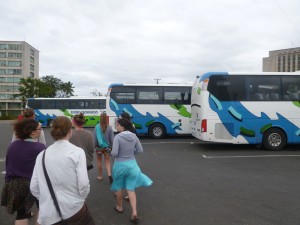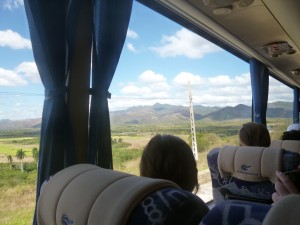“Best Yutong”: Chinese Buses and Cuba’s Tourist Infrastructure
April 29, 2012 by admin
Every day of our trip to Cuba was packed full of different activities: meetings with musicians, cooperative farmers, college professors and representatives from various governmental organizations and NGOs, not to mention visits to more traditional tourist sites and cities like Cienfuegos, Trinidad and Santa Clara. But in between these meetings and visits, we spent several hours a day being driven from place to place on a large tour bus. It was just one of the 7,000 new buses (according to our guide Joel) that the Cuban government has purchased from the Chinese company Yutong since 2005.[1] While some of the thousands of new buses have been incorporated into public transport and the national bus system for regular Cubans (I saw only one new Yutong bus being used for public transport in Havana), a large number of them are devoted exclusively to the more lucrative tourism industry. This raises several problems that the Cuban government will have to face as tourism increasingly drives the island’s economy: first, by giving tourists the most expensive and comfortable means of transportation available, the Cuban government gives them privileges that far exceed those given to regular Cubans and limits the contact foreigners have with Cubans outside of tourism and related industries. The second problem is that by focusing on short term expansion of tourism infrastructure, the Cuban government risks neglecting the country’s regular infrastructure needs and ultimately harming the long-term expansion of both domestic and international tourism.
There are several fairly obvious reasons for the Cuban government to use its new buses for tourist groups, the most basic of which is that tourist groups provide large amounts of money that the government can spend on its budget priorities of healthcare and education. The Cuban government is also aware that most the tourists who visit the island are from North America and Western Europe and expect faster and more comfortable transportation than Cubans do. Beyond these fairly obvious reasons, there also lies Cuba’s desire to control tourism so that it does not interfere with the government’s larger goals. By transporting tourists around the country in government owned buses, the government is able to quite rigidly control where most tourists go, where they spend their money and who they interact with. The government sees this as desirable because Cubans are less exposed to the potentially corrupting influence of foreigners and tourists are “protected” from potential “harassment” by jineteros or even from Cubans who are just interested in talking to them.
The problems this privileged isolation the Cuban tourist industry provides are evident even now but could grow as the industry expands, especially if the U.S. embargo ends in the near future. Although Cubans seem to understand the government’s motives in providing tourists with exclusive resorts, hotels and transportation, resentment may grow over time if the money generated from tourism does provide material benefits outside of simply maintaining existing social programs. Furthermore, by controlling where tourists go and spend money, as well by having them use an alternate and much more valuable currency (the CUC as opposed to the regular Cuban peso), the government limits the number of people who can benefit directly from tourist spending to a small number of people who work in tourism industries and have direct contact with visitors. This is already creating growing income inequality that will only grow as time goes on and it could become much more difficult for the Cuban government to defend its practices.[2]
In addition to the purchase of buses for tour groups, the government has also spent considerable amounts of money building new resorts, mostly as joint ventures with European and Canadian investors. Tourism statistics from the Oficina Nacional de Estadisticas reflect these new investments. In 2005, there were a total of 450 hotels with 45,999 rooms in the entire country. By 2008, there were only 414 hotels but the number of rooms available had gone up to 48,638. In 2010, the last year for which records are available, the number of hotels had started to go up again, to 434, and there were 56,432 rooms available, an increase of over 10,000 rooms from 2005, representing an increased capacity of almost 23%.[3] The smaller number of hotels overall, along with the increase in the number of rooms, suggests that the Cuban government has been either eliminating or renovating existing hotels and prioritizing massive resorts like the kind we saw during our stay in Varadero.
Although these new resorts, along with the addition of the new buses, will allow for the expansion of the tourist industry under the existing system, I think it would make more sense for Cuba to pursue some sort of unified infrastructure, instead of strictly separating tourist infrastructure from that used by Cubans. Outside of organized tour groups that rent individual buses, there is already a national bus system called Víazul that is, in theory, available to both tourists and Cubans.[4] Nonetheless, since the prices for Víazul are in CUCs, tickets are far too expensive for most Cubans, except, perhaps, those who work in the tourism industry. The majority of Cubans are forced to either hitchhike across the island or take the less reliable Astro bus line, which is targeted specifically at Cubans. Ultimately, it would make the most sense and be most efficient if all transportation were reliable, comfortable and available to both Cubans and tourists. The reason this probably won’t happen anytime soon is that it would require the Cuban government to tackle the contradictions it has created through the expansion of tourism over the last 20 years. Cuba would need to address the inequalities inherent to the dual currency economy and figure out a fair way to allow both tourists and Cubans to use the same infrastructure. Only in this way would the massive investments in the tourism sector bring real material benefits to Cubans and not just preserve the status quo.
[1] “Yutong Got a Big Order From Cuba,” May 13, 2005, http://www.chinabuses.com/english/spotlight/yutong.htm.
[2] Marc Frank, “Cuba Grapples with Growing Inequality,” Reuters, April 10, 2008, http://www.reuters.com/article/2008/04/10/us-cuba-reform-inequality-idUSN1033501920080410.
[3] Oficina Nacional de Estadísticas Republica de Cuba, “Establecimientos, habitaciones y plazas de servicios de alojamiento,” Anuario estadístico de Cuba 2010, http://www.one.cu/aec2010/esp/15_tabla_cuadro.htm.
[4] Wikitravel, “Cuba – Get Around,” http://wikitravel.org/en/Cuba#Get_around.
One Response to ““Best Yutong”: Chinese Buses and Cuba’s Tourist Infrastructure”
Leave a Reply
You must be logged in to post a comment.




Cuban eight
blog topic